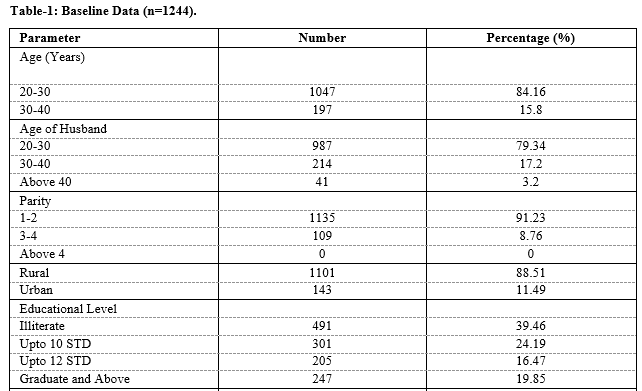A study on awareness and behavior of women towards contraceptive use among women attending tertiary care center in northern Andhra Pradesh, India
Abstract
Background: In spite of the constant efforts by the government, the unmet need for contraception (12.8% in 2006 WHO report) is still there. There are many social factors, taboos, myths, and ignorance, which is responsible for the underutilization of contraceptive services. This leads to many unwanted pregnancies causing maternal morbidity and mortality. The aim of the study was to assess the knowledge, attitude, practices, and behavior of women regarding various contraceptive methods.
Material and Methods: It was a cross-sectional study of 1244 married women attending gynaecology OPD of Great Eastern Medical School and Hospital, Srikakulam, Andhra Pradesh (India). All participants were interviewed with a predesigned proforma.
Results: Almost 88.5% of women were from a rural area and more than one-third were illiterate, belonging to low socioeconomic status. Awareness level about contraceptive methods was 92.3% among the participants and almost all of them knew about barriers and oral pills. The main source of knowledge was Healthcare Workers followed by media and social circles. Approximately 43.5% were currently using one or the other method of contraception. The barrier method was the most commonly used. The main reason for not using contraception was Desirous for Conception.
Conclusion: There is a need to create awareness about the benefits of contraception.
Downloads
References
Kaushal SK, Saxena SC, Srivastava VK, Gupta SC, Nigam S. KAP study on contraceptive methods in Kanpur district of UP. Ind J of Community Health. 2009;21(1):33-38.
Govt. Of India: Manual on decentralized participatory planning in Family Welfare Programme 1996, 1-3.
Govt. Of India: Ministry of Health and Family Welfare, Department. Of Family Welfare. Manual on community needs assessment approach in the family welfare programme, 1998, 1-3.
Unmet need of contraception, WHO 2013 update. Available at https://www.who.int/reproductivehealth/topics/family_planning/unmet_need_fp/en/.
Hogmark S, Klingberg-Allvin M, Gemzell-Danielsson K, Ohlsson H, Essén B. Medical students’ knowledge, attitudes and perceptions towards contraceptive use and counselling: a cross-sectional survey in Maharashtra, India. BMJ Open. 2013;3(12). doi: https://doi.org/10.1136/bmjopen-2013-003739.
Collumbien M, Gerressu M, Cleland J. Non-use and use of ineffective methods of contraception. In: EzzatimM, Lopez AD, Rodgers AMurray CJL. Eds. Comparative quantification of health risks: Global and regional burden of disease attributable to selected major risk factors. Geneva: World Health Organization, 2004:1255-1320. Available at http://researchonline.lshtm.ac.uk/17866/
Pegu B, Gaur BP Singh, Sharma N, Singh AS. Knowledge, attitude and practices of contraception among married women. Int J Reprod Contracept Obstet Gynecol. 2014;3(2):385-388. doi: http://dx.doi.org/10.5455/2320-1770.ijrcog20140620.
Sunita TH, Desai RM. Knowledge, attitude and practice of contraception among women attending a tertiary care hospital in India. Int J Reprod Contracept Obstet Gynecol. 2013; 2(2):172-176. doi: http://dx.doi.org/10.5455/2320-1770.ijrcog20130612.
Sultan K, Younus S. Mass media and family planning: understanding the effects of television in innovation decision process of health communication in district Peshawar. KUST Med J. 2010;2(2):58-63.
Senbeto E. A study on knowledge, attitude, practice and quality of care in family planning at Dessie Zuria District. J Ethiop Med Pract. 2001;3(2):70-76. doi: https://doi.org/10.4314/jemp.v3i2.10600.
Jabeen M, Gul F, Wazir F and Javed N. Knowledge, attitude and practices of contraception in women of reproductive age. Gomal J Med Sci. 2011;9(2):223-229.
Srivastava R, Srivastava DK, Jina R, Srivastava K, Sharma N, Saha S. Contraceptive knowledge, attitude and practice (KAP Survey). J Obstet Gynaecol India. 2005;55(6):546-550.

Copyright (c) 2020 Author (s). Published by Siddharth Health Research and Social Welfare Society

This work is licensed under a Creative Commons Attribution 4.0 International License.


 OAI - Open Archives Initiative
OAI - Open Archives Initiative



















 Therapoid
Therapoid

